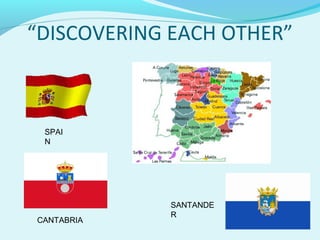
English presentation of santander and cantabria
- 1. “DISCOVERING EACH OTHER” SPAI N SANTANDE R CANTABRIA
- 2. Some facts about us Official name: Kingdom of Spain. Capital city: Madrid. Population: 47 million people. Currency: euro. Official Languages: Spanish, Catalan, Galician, Basque. Government: Spain is a democracy. It is a constitutional monarchy. The head of state is King Juan Carlos I. We have a bicameral parliament , with a congress and a senate. The head of the government is Mariano Rajoy. The country is divided in 17 autonomous communities and 2 autonomous cities (Ceuta and Melilla). One of this regions or autonomus communities is Cantabria. Spain became a member of the European Union on 1st January 1986.
- 3. Where is Santander? Santander is the capital of Cantabria, a region situated in the north of Spain.
- 4. Means of transport. You can come to Santander by… Plane: there are domestic and train international flights Ferry from the south of England Bus. This is the bus station.
- 5. Santander Our city has about 178,000 inhabitants. It is a city by the sea with a beautiful bay and some nice beaches. In 1941 a great fire destroyed most of the old part of the city, that’s why there aren’t many old buildings in it.
- 6. Some interesting places and buildings in the city The bay, pereda street and gardens
- 7. Some interesting places and buildings in the city Town hall Cathedral Maritime museum Post office
- 8. Some interesting places and buildings in the city Concert hall Football stadium and sports palace Esperanza market Porticada square
- 9. The Palace of La Magdalena is the most emblematic building of the city . it is situated at the highest point of the Magdalena Peninsula and surrounded by a public park. Built between 1908 and 1912 as a present to the Royal family, it celebrates its 100 anniversary this year. it was the summer residence of the Royal family for some years. In 1977 it was sold back to the city. Today, the Palace is the venue for congresses and meetings and Summer headquarters of the prestigious Menéndez Pelayo International University. Palace and Peninsula of La Magdalena
- 10. Sardinero and City Beaches Sardinero is the beach area of the city. In the summer it is always crowded. This beach is called “Camel beach”. Can you guess why?
- 11. Cantabria • Cantabria is one of the autonomous communities in Spain with a population of about 590,000 people. • Fishing, agriculture, some industries and tourism play an important role in our economy. • Its landscapes is made up of beaches, mountains and inland valleys.
- 12. Weather The weather is quite mild, neither too cold nor too hot, with average temperatures of 12ºC in winter and 23º in Summer; except in the mountians where it snows and temperatures are much colder. We get quite a lot of rain, that’s why everything is green. The map shows a typical spring or autumn day in Cantabria.
- 13. Towns and villages. What can Prehistoric caves. you visit in Beaches. Cantabria? Natural parks.
- 14. Towns and villages Torrelavega, the 2nd largest town in Cantabria and Reinosa are two industrial towns.
- 15. Towns and villages by the sea All along the coast you can find fishing towns and villages, nowadays tourist destinations too, such as… Santoña, in the west, well-known for the production of anchovies Suances San Vicente Comillas de la with its Barquera modernist architecture
- 16. Towns and villages If you want to see examples of traditional architecture (stone houses, wooden balconies and red roofs), these are some of the places you can’t miss. Santillana del Mar. Potes, in the Picos de Europa mountain area Bárcena Mayor
- 17. Prehistoric caves. Cantabria is the richest region in the world in archaeological sites from the Upper Paleolithic. One of the most important ones is Altamira Cave Altamira Cave. Inhabited between 22,000 and14,000 BC, it has incredible paintings of bisons and deer dated between 16,00 and 9,000BC World heritage site by UNESCO since 1985, in 2003, 17 more caves, 9 of them in Cantabria were included on this list as Cave of Altamira and Paleolithic Cave Art of Northern Spain. The caves are inscribed as masterpieces of creative genius and as the humanity’s earliest accomplished art. The cave is closed to visitor to protect the paintings, but you can visit its reproduction in the nearby Altamira museum. The other caves with painting are open to the public.
- 18. Caves El Soplao Cave This cave was discovered at the beginning of the 20th century when the mines of La Florida were being operated. It is considered to be one of the greatest wonders of geology, and a true paradise for potholers (eccentrics, stalactites, stagmalites, gorges, columns, cave pearls, etc.)
- 19. Mountains, Valleys and Natural Parks Picos de Europa The largest protected area in Spain, with 700 km 2 spread between 3 regions: Cantabria, Asturias and León. The highest mountains of the regions are here. (Torre Blanca (2,615 m). There are beech and oak forests, as well as several species of animals in danger of extinction (brown bear and grouse mostly), and others like chamois, deer, wild boar and wolf.
- 20. Mountains, Valleys and Natural Parks Nature at its best in Pas Valley the Saja-Besaya nature park
- 21. CANTABRIA If you click on the link below you can watch a short video in English about our region made by the Cantabria tourist board. http://youtu.be/QPMYFyiiuUw You can also watch a video with images of the region and listen to a modern folk song by a group from Cantabria called Tanea. The name of the song is Viento del norte “North Wind”. In this video they sing with Victor Manuel,a famous singer songwriter. http://youtu.be/YUtg0_FvMto We would love to show you some of these places when you come to visit us.
Notas del editor
- IVAN
- CELIA